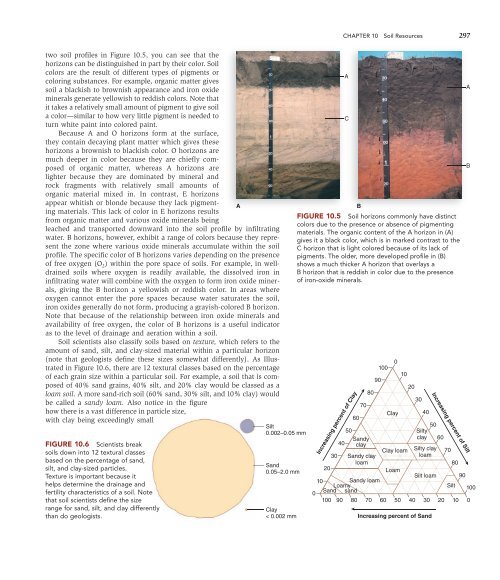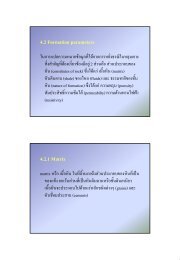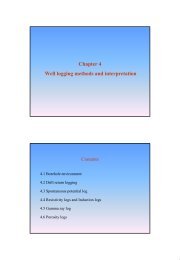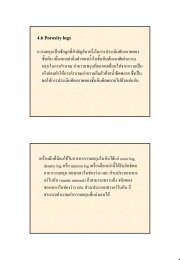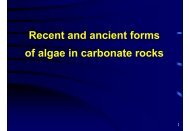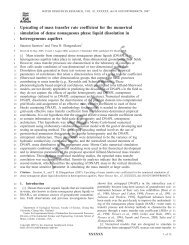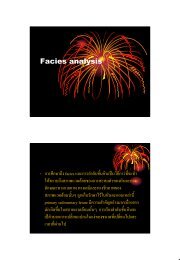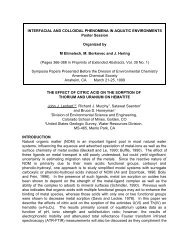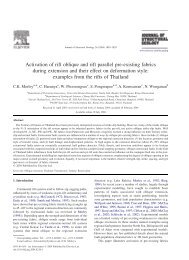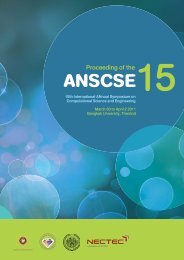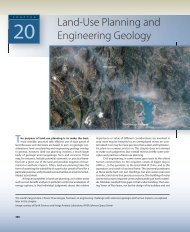Soil Resources - Geological Sciences, CMU
Soil Resources - Geological Sciences, CMU
Soil Resources - Geological Sciences, CMU
Create successful ePaper yourself
Turn your PDF publications into a flip-book with our unique Google optimized e-Paper software.
CHAPTER 10 <strong>Soil</strong> <strong>Resources</strong> 297two soil profiles in Figure 10.5, you can see that thehorizons can be distinguished in part by their color. <strong>Soil</strong>colors are the result of different types of pigments orcoloring substances. For example, organic matter givessoil a blackish to brownish appearance and iron oxideminerals generate yellowish to reddish colors. Note thatit takes a relatively small amount of pigment to give soila color—similar to how very little pigment is needed toturn white paint into colored paint.Because A and O horizons form at the surface,they contain decaying plant matter which gives thesehorizons a brownish to blackish color. O horizons aremuch deeper in color because they are chiefly composedof organic matter, whereas A horizons arelighter because they are dominated by mineral androck fragments with relatively small amounts oforganic material mixed in. In contrast, E horizonsappear whitish or blonde because they lack pigmentingmaterials. This lack of color in E horizons resultsAfrom organic matter and various oxide minerals beingleached and transported downward into the soil profile by infiltratingwater. B horizons, however, exhibit a range of colors because they representthe zone where various oxide minerals accumulate within the soilprofile. The specific color of B horizons varies depending on the presenceof free oxygen (O 2 ) within the pore space of soils. For example, in welldrainedsoils where oxygen is readily available, the dissolved iron ininfiltrating water will combine with the oxygen to form iron oxide minerals,giving the B horizon a yellowish or reddish color. In areas whereoxygen cannot enter the pore spaces because water saturates the soil,iron oxides generally do not form, producing a grayish-colored B horizon.Note that because of the relationship between iron oxide minerals andavailability of free oxygen, the color of B horizons is a useful indicatoras to the level of drainage and aeration within a soil.<strong>Soil</strong> scientists also classify soils based on texture, which refers to theamount of sand, silt, and clay-sized material within a particular horizon(note that geologists define these sizes somewhat differently). As Illustratedin Figure 10.6, there are 12 textural classes based on the percentageof each grain size within a particular soil. For example, a soil that is composedof 40% sand grains, 40% silt, and 20% clay would be classed as aloam soil. A more sand-rich soil (60% sand, 30% silt, and 10% clay) wouldbe called a sandy loam. Also notice in the figurehow there is a vast difference in particle size,with clay being exceedingly smallFIGURE 10.6 Scientists breaksoils down into 12 textural classesbased on the percentage of sand,silt, and clay-sized particles.Texture is important because ithelps determine the drainage andfertility characteristics of a soil. Notethat soil scientists define the sizerange for sand, silt, and clay differentlythan do geologists.Silt0.002–0.05 mmSand0.05–2.0 mmClay< 0.002 mmACBFIGURE 10.5 <strong>Soil</strong> horizons commonly have distinctcolors due to the presence or absence of pigmentingmaterials. The organic content of the A horizon in (A)gives it a black color, which is in marked contrast to theC horizon that is light colored because of its lack ofpigments. The older, more developed profile in (B)shows a much thicker A horizon that overlays aB horizon that is reddish in color due to the presenceof iron-oxide minerals.Increasing percent of Clay203040506070Sandyclay80Sandy clayloam9010010 Sandy loam0Sand Loamysand100 90 80 70 600Clay5010Clay loamLoam20403040Siltyclay30Increasing percent of SandIncreasing percent of Silt50Silty clayloamSilt loam60207080Silt1090AB1000


